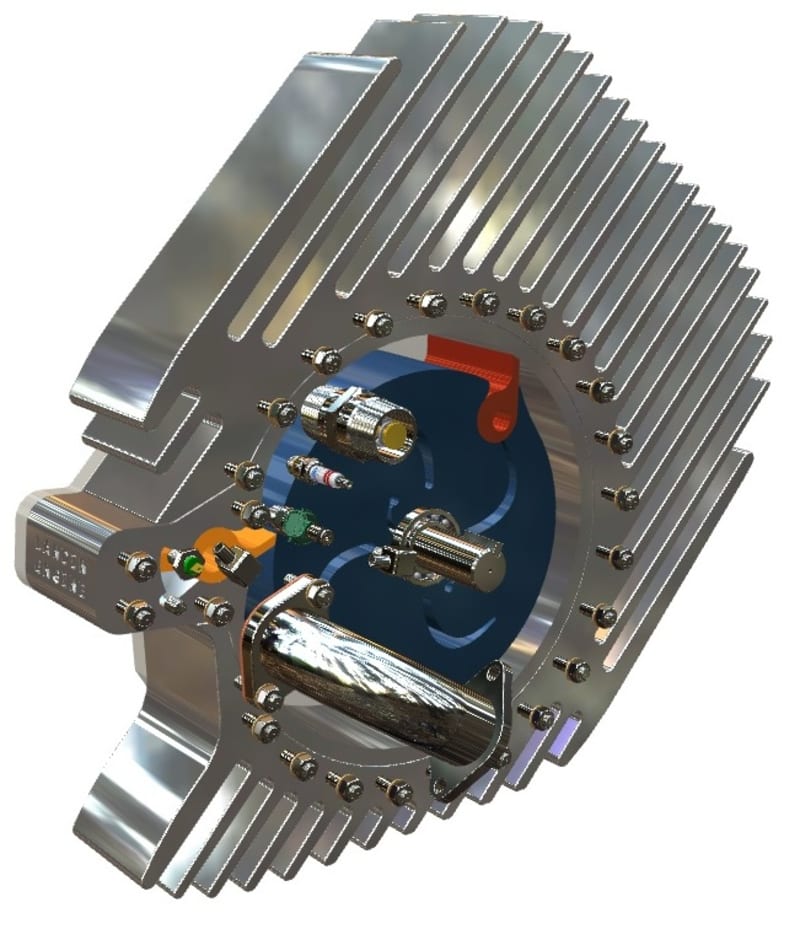
THE LANDIN ENGINE
Invented by Peter Landin. It has only three moving parts, and may be the engine of the future. The moving parts: a rotor (in blue), an orbital swivel valve (in red), and a stationary swivel valve (in yellow), form a variable combustion chamber. As this chamber increases its capacity, it generates a vacuum and suctions a mass of air through the intake check valve. Direct injected fuel mixes with this air mass to form a combustible atmosphere. When ignited, the combustion closes the intake check valve instantaneously and forces the orbital swivel valve and rotor to rotate as one piece, transferring a high-power, high-torque rotation. This unique design allows heat dissipation through an aluminum jacket that fits around the engine. The heat-dissipating element wraps around the engine housing and can be of different designs, maximizing the engine’s versatility for a wide range of applications. This engine can be air-cooled or water-cooled, depending on the heat-dissipating element design used.
Different combustibles are suitable, such as gasoline, gasohol, butane, propane, or hydrogen to name a few; in fact any fuel able to form a combustible atmosphere is an option. Every part, except for the output shaft and related hardware, can be fabricated using a “CNC Water Jet” cutting machine. This allows the manufacturing of this engine to be simple and low cost. This engine can be one inch to a few feet in diameter. Different sizes can be used in many applications: automobiles, motorcycles, watercrafts, aircrafts, and larger versions for electrical power generators and construction machinery. You may wonder, “How does the Landin Engine compare to other engine designs like the Wankel rotary engine, and many other two-stroke and four-stroke designs.” There is no comparison.
The Landin Engine is the first “COMPRESSION-LESS ORBITAL EXPANSION ENGINE” in the world.
A conventional four-stroke engine uses one revolution of the crankshaft for admission and compression and a second revolution for combustion and exhaust, where only half of the second revolution is used to transfer power. Now, after 135 years of the Otto Cycle engine, the Landin Engine breaks the paradigm by achieving admission, combustion, and exhaust in a single revolution without using compression. A conventional four-cylinder crankshaft has a turning diameter of about five inches. The equivalent Landin Engine has a turning diameter of twelve inches. This produces a dramatic increase in power. When compared to a small four-cylinder engine, the small size and low weight of the Landin Engine allows multiple units to be coupled in line to achieve more power in less space, with virtually no vibrations; a good alternative for turbines. This engine does not require an oil pump, because the oil is distributed by centrifugal forces through four slots in the rotor lubricating the few friction areas. This oil does not return to the oil reservoir, therefore, no oil filter is needed. Best of all, it uses much less fuel than today’s power-equivalent engines, making this engine the right choice for a green planet.
-
Awards
-
 2011 Top 10 Most Popular
2011 Top 10 Most Popular
Like this entry?
-
About the Entrant
- Name:Peter Landin
- Type of entry:individual
- Software used for this entry:Autodesk Inventor
- Patent status:pending








